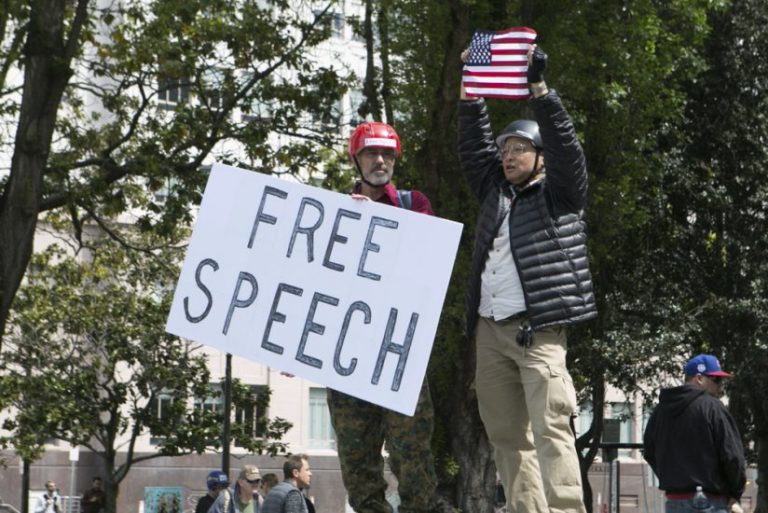Commentary and Analysis: The Sines v. Kessler Lawfare Jury Verdict
by Glen Allen, Esq.
As I stated in my November 19, 2021 article, in my view – what I think is the view of any impartial person – the Sines v. Kessler litigation is ideological lawfare. On November 24, 2021, the jury reached a verdict in that case. I now offer some initial thoughts about that verdict, with the caveat that many critical motions and rulings will likely be made in the next few weeks that could greatly affect the future path of the litigation.
Background. On October 11, 2017, 10 plaintiffs commenced the Sines v. Kessler litigation in federal court in Charlottesville against 25 defendants. On October 25, 2021, more than four years later – four years of expensive, time-consuming, stressful litigation – the case went to a jury. By this time, there were nine plaintiffs and 17 defendants (eight had defaulted or never been served). The nine plaintiffs alleged six claims against all or a subset of the 17 defendants, namely two federal claims under the 1871 Civil Rights Act (42 U.S.C. Sections 1985(3) and 1986) for conspiracy to commit racial violence (all plaintiffs against all defendants); a claim under Virginia state law for civil conspiracy to violate numerous Virginia state laws (all plaintiffs against all defendants); a claim under a Virginia statute prohibiting racial, religious, or ethnic harassment or violence (two plaintiffs against five defendants); and two claims, one for assault and the other for intentional infliction of emotional distress, brought by six plaintiffs against defendant James Fields. Plaintiffs sought both compensatory and punitive damages on all six of their claims and attorney fees on their two federal civil rights claims.
On the afternoon of November 24 – one day before Thanksgiving – the jury, consisting of four black and eight white jurors, after deliberating for more than three days (and causing concerns of a jury deadlock), rendered its verdict. It did so by means of a problematic jury verdict form that bore a resemblance to a Rubik’s Cube. The jury deadlocked on the two federal civil rights claims and left those portions of the verdict form blank. On the third claim, for civil conspiracy under Virginia law, the jury found against all 17 defendants. As to two of the plaintiffs, however – Elizabeth Sines and the Reverend Seth Wispelwey – the jury found no compensatory damages. As to the other seven, it found $1 each in compensatory damages. It then awarded $500,000 in punitive damages against each of the 12 individual defendants and $1,000,000 in punitive damages against each of the five organizational defendants.
On the fourth count, for racial or ethnic harassment, the jury found for the two plaintiffs, awarding each $250,000 in compensatory damages and imposing $200,000 in punitive damages against each of the five defendants. On the fifth and sixth claims against James Fields, the jury awarded compensatory damages to the six plaintiffs in various amounts ranging from $0 to $318,575 and imposed $6,000,000 in punitive damages against Fields on each count.
Analysis and Comment. Articles in the mainstream media describing the verdict – stating, for example, that the jury awarded $25 million in damages – while accurate in some respects are incomplete in others. In my judgment, there are several substantial grounds for reducing the verdict to a small fraction of the $25 million amount. These grounds include:
The Virginia Statutory Cap on Punitive Damages. Section 8.01-38.1. of the Virginia Code provides as follows:
In any action accruing on or after July 1, 1988, including an action for medical malpractice under Chapter 21.1 (§ 8.01-581.1 et seq.), the total amount awarded for punitive damages against all defendants found to be liable shall be determined by the trier of fact. In no event shall the total amount awarded for punitive damages exceed $350,000. The jury shall not be advised of the limitation prescribed by this section. However, if a jury returns a verdict for punitive damages in excess of the maximum amount specified in this section, the judge shall reduce the award and enter judgment for such damages in the maximum amount provided by this section.
By its plain language, the statute caps the plaintiffs’ punitive damages claims against all defendants at $350,000. Application of this cap would leave the two $250,000 compensatory damages award in Count Four and the compensatory damages awards against Fields in Counts Five and Six, but would substantially reduce the total damages. My research has not yet disclosed how the $350,000 in punitive damages would be allocated among the 17 defendants and nine plaintiffs, an important question the jury verdict form does not address.
Due Process Limitations. Federal and state constitutional due process restrictions impose significant limitations on punitive damages awards. More specifically, they impose several proportionality requirements.
The first is a reasonable ratio, consistent with the purpose of punitive damage awards, between actual and punitive damages. My far-from-exhaustive research indicates that in Virginia, as in federal courts and many other state jurisdictions subject to similar due process restraints, while there is no fixed ratio, ratios above 20X – 30X draw increased judicial scrutiny. The ratios on the jury’s Count Three award, however, are astronomic: 500,000,000 to one, if I’m counting my zeros right. Even if the punitive damages award was reduced to $350,000, the ratios would still be very high, depending on how the $350,000 was allocated between the different counts and defendants. So this proportionality rule could provide a strong basis for further reducing the punitive damages award, at least as to the third count.
The second proportionality requirement is a reasonable relationship between the punitive damages award and the reprehensibility of the defendants’ conduct. Application of this requirement to the jury’s award raises difficult and important First Amendment questions. What was “reprehensible” about the defendants’ conduct? As to the third count, in which the plaintiffs were awarded only $1 in compensatory damages (or none at all) and accordingly were found to have suffered no physical harm, the “reprehensibility” must have been entirely in the defendants’ message. But our courts recite time and again that the First Amendment protects expression that others may find reprehensible. As Justice Holmes stated in his U.S. v. Schwimmer (1928) dissent, the core purpose of the First Amendment is to protect “freedom for the thought we hate.” So awarding large punitive damages – or any at all – based on the “reprehensibility” of the defendants’ message should offend a court’s constitutional sensibilities.
A third due process ratio is between the punitive damages award and the defendants’ ability to pay. The Supreme Court has made clear that punitive damages are allowed only to admonish and chastise wayward defendants, not destroy them. In this case, large punitive damage awards could cripple many if not all the defendants.
In summary, there are many grounds for challenging the punitive damages awards. These are in addition to many other possible grounds for overturning the verdict, including the court’s evidentiary rulings.
Procedural Issues. The jury’s deadlock on the first two counts creates considerable procedural complexity in moving the case forward. Post-judgment motions – such as a motion for remittitur to reduce the punitive damages award – can be filed only after entry of final judgment and no judgment can be entered on the jury’s verdict until all claims have been resolved unless the court so directs under Federal Rule 54(b). It is not clear whether the plaintiffs would agree to a Rule 54(b) motion requesting the court to enter judgment as to the four counts that the jury did decide.
What does seem likely is that the plaintiffs will seek to refile as to the two deadlocked counts, thereby, if they succeed, adding yet another lengthy and expensive chapter to this already brutal lawfare.
If you would like to help us continue our work, please consider making a small tax-deductible donation to the FEF. Every dollar counts in our fight to keep Free Expression free. Click the DONATE button at the top right corner of this page, and thank you!
*** IMPORTANT DISCLAIMER***
Information herein and throughout this website is for educational purposes only and does not constitute legal advice directed towards individuals, groups, or organizations.
FEF does maintain relationships with lawyers, law firms, and other experts throughout the United States and can help direct people towards such resources and, to an extent, serve in an advisory capacity. But the FEF is not, in any way, a law firm or legal partnership.
The FEF recommends that legal advice should always be obtained by a qualified attorney licensed to practice law in the relevant jurisdiction.







